The August Consumer Price Index, which measures inflation, increased 0.6% from July. This is the largest monthly increase since June 2009 and the reason for the jump is 80% gasoline prices. The CPI gasoline index increased a whopping 9.0% in a month. When removing food and energy inflation, of which gasoline is a part, core inflation increased 0.1% for August. Below is CPI's monthly percentage change.

CPI is up 1.7% from a year ago, shown in the below graph.
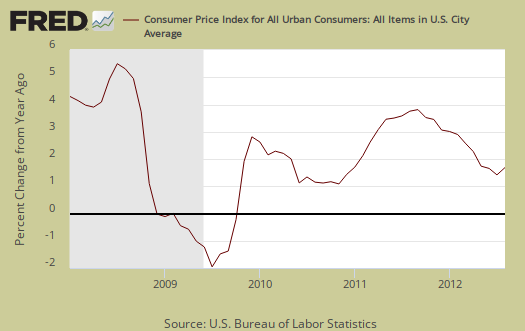
Energy overall jumped 5.6% for August, but is still down -0.6% for the last 12 months. Don't expect that yearly change to last. The BLS separates out all energy costs and puts them together into one index. Energy costs are also mixed in with other indexes, such as heating oil for the housing index and gas for the transportation index. Fuel oil for the month increased 4.6% and natural gas also increased 2.8% for August. Below is the overall CPI energy index, or all things energy.
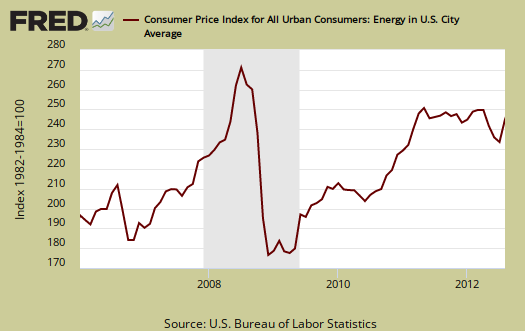
Graphed below is the household energy index which includes electricity and natural gas, shown by monthly percentage change. This month the index increased 0.9% and for the last 12 months has declined -3.7%. This is a different, special index to show the overall costs for energy into your home only, (unless you drive your car in your mansion or run generators for your tent).
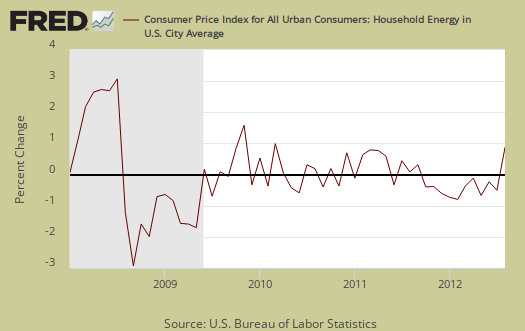
Graphed below is the CPI gasoline index, which increased 9.0% this month.
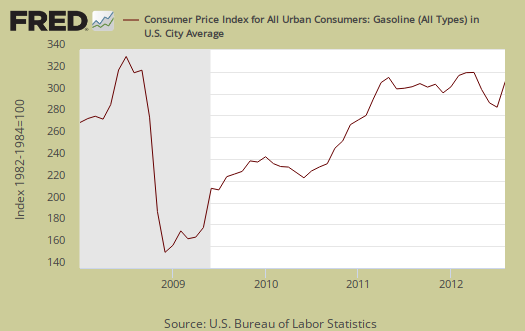
Below are gas prices, last updated September 10th. We can see gas prices are roaring back and projections are gas will stay high. We now have more quantitative easing and Middle East social unrest, so lord knows how high they will go now. High oil prices have a strong correlation with recessions.
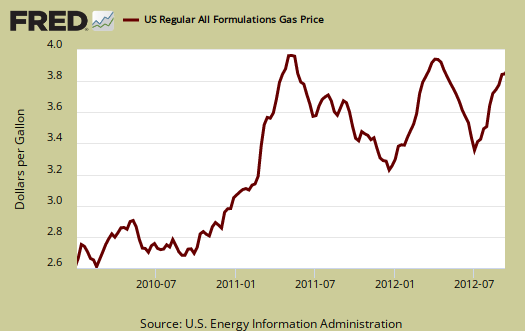
Core inflation, or CPI minus food and energy, increased 0.1% for August, the 2nd month in a row. Core inflation has risen 1.9% for the last yearly time window and is the smallest increase since July 2011. Core CPI is one of the Federal Reserve inflation watch numbers. These low figures probably helped justify more quantitative easing, which increases commodity prices.
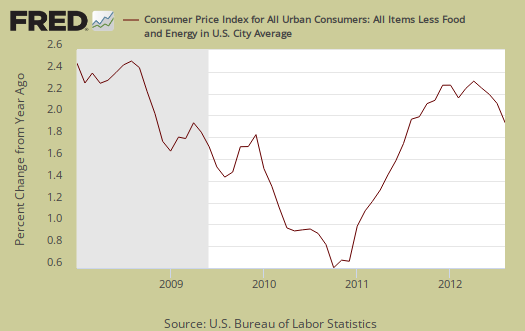
Core CPI's monthly percentage change is graphed below.
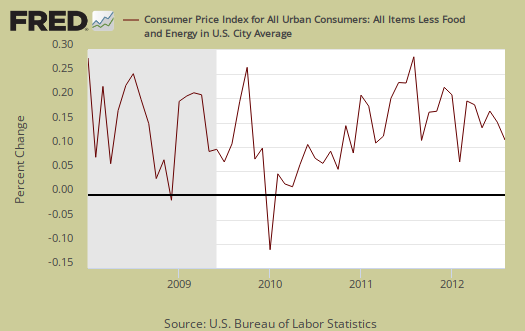
Shelter increased 0.2% and is up 2.1% for the year. Rent increased 0.2% and the cost of renting has increased 2.6% for the last 12 months. Hotels & Motels declined -0.9% for the month. Used cars & trucks declined -0.9%, while new autos increased 0.2% for August. Apparel declined -0.5% and drinking yourself to death dropped -0.2% and booze at home declined -0.4%. Educational books increased 1.3% in a month with college textbooks increasing another 1.4%. Airfares declined another -1.3%.
Graphed below is the percentage change from a year ago of rent, the largest monthly household expense for people who can least afford increases as those with less money disproportionately rent vs. own.

Food and beverages overall increased 0.2% for August and are up 1.7% from a year ago. The food at home index (think groceries) increased 0.1% from July. This is becoming increasingly hard to believe, and is up 1.5% for the year. Anyone going to the grocery has to be questioning these figures at this point and soaring prices have been blamed on the drought. Bacon did increase 3.6% in a month. Eggs jumped 5.0%, Fresh Fruits & veggies increased 0.5%, cheese increased 0.9% and fresh whole chicken declined -2.1%. Pork chops increased 1.1%. Yet hamburger had no change and the report claims beef steaks actually dropped -1.0% from July to August. Due to CPI substitutions, we believe one needs to look at the price increases of individual items. There is only so long one can substitute 27% lard hamburger for steak here and claim food inflation is low and then what steak dropped an entire percentage point in a month? Shoe leather steak?
Eating out, or food away from home increased 0.3% from last month and is up 2.8% from a year ago.
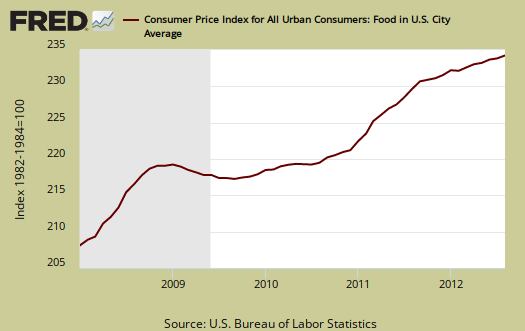
The Medical care index increased 0.2% and has increased 4.1% over the last 12 months. Physicians increased 0.3%, yet hospitals finally showed a decrease of -0.4% for the month. Not to fret you for profit health care, hospitals are still up 4.7% for the year. Medical commodities are things like your prescription drugs and increased 0.3% and are up 3.6% for the year. Below is a bar graph of the Medical index. Nowhere else do we see a ridiculous, constant to the point the graph forms a triangle, increase in costs like the below for Medical care.
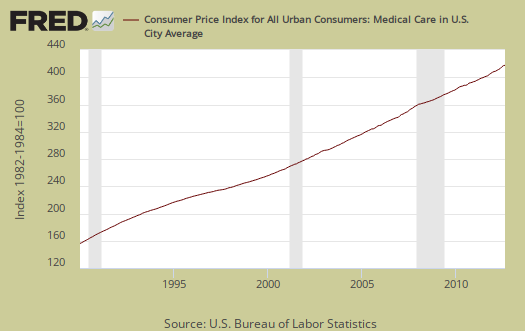
The cost of having a checking account increased 1.2% in a month and has increased 7.4% in a year. Unreal and seems being fee'd to death is alive and well from the Banksters.
According to the BLS, for the year, food and beverages, which includes food at home, made up 15.2% of the index. Housing is 40.9% and transportation, including gas for the car, is 17.2% and all energy is 10%. Medical care is only 7.1%, they claim. All items minus food and energy are considered 75.8% of the total price expenditures for consumers.
The DOL/BLS does take yearly surveys on where the money goes in the monthly budget, but as one can see, food and energy are significant amounts of the monthly finances. Run away costs in these two areas can break the bank, so can food. Additionally CPI uses substitution, so if steak goes through the roof, somehow we're all just fine with hamburger and prices didn't really overall increase much. If we see food inflation flat over the next year, we know something is wrong with the measurement as the drought is projected to dramatically increase food prices.
CPI-W for the month, unadjusted was 227.056, a 1.7% increase for the year, and increased 0.7% for the month, although not seasonally adjusted. CPI-W is used to calculate government transfer payments, such as social security increases.
Last month's CPI report overview, unrevised, although most graphs are updated, is here.
If you're wondering why the graphs look weird, the graph calculates percentages from the index and doesn't round. The actual data from the BLS report does round to one decimal place. In other words, 0.05% is rounded to 0.1%.

Recent comments